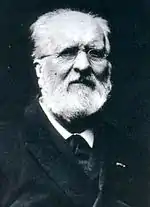Louis Laurent Gabriel de Mortillet
Louis Laurent Gabriel de Mortillet (29 August 1821 – 25 September 1898), French archaeologist and anthropologist, was born at Meylan, Isère.
Louis Laurent Gabriel de Mortillet | |
|---|---|
 Louis Laurent Gabriel de Mortillet | |
| Born | 29 August 1821 |
| Died | 25 September 1898 (aged 77) |
| Nationality | French |
| Scientific career | |
| Fields | anthropology |
Biography
Mortillet was educated at the Jesuit college of Chambéry and at the Paris Conservatoire. Becoming in 1847 proprietor of La Revue indépendante, he was implicated in the Revolution of 1848 and sentenced to two years' imprisonment. He fled the country and during the next fifteen years lived abroad, chiefly in Italy.[1]
In 1858 he turned his attention to ethnological research, making a special study of the Swiss lake-dwellings. He also issued three works on the evidence for early man in North Italy, the third making a then unprecedented association with the Ice Age.[2] He returned to Paris in 1864, and soon afterwards was appointed curator of the museum at St Germain. He became mayor of the town, and in 1885 he was elected deputy for Seine-et-Oise.[1]
He had meantime founded a review, Matériaux pour l'histoire positive et philosophique de l'homme, and in conjunction with Broca assisted to found the French School of Anthropology. He died at St Germain-en-Laye on 25 September 1898.[1]
Typological stages
Mortillet is best known for his clarification and ordering of the archeology of the Paleolithic.[3] Where Édouard Lartet had used fauna as a distinguishing feature – Mammoth against Reindeer – for his important discoveries, Mortillet realised that as fauna varied with latitude they were unreliable indicators, and proposed instead a classification by means of dwelling places: Alluvial or Cave epochs, for example.[4] Later acknowledging the ambiguity in that system as well, he published a new classification in 1869, using type sites and their associated artifacts to distinguish and name periods: (Chellian, Mousterian, Solutrean, Magdalenian, Robenhausen).[5] His system may have subsequently been refined, but still remains in current use. However, whereas Mortillet believed his classifications were universal stages, with a unilineal evolution, later thinking regards each culture as a more localised conglomerate, capable of overlapping in time with others, not necessarily lineally related.[6]
Mortillet proposed the name "Marnian Epoch" as a replacement for the period usually called the Gallic, which extends from about five centuries before the Christian era to the conquest of Gaul by Caesar. Mortillet generally objected to the term Gallic, as the civilization characteristic of the epoch was not peculiar to the ancient Gauls, but was common to nearly all Europe at the same date. The name is derived from the French département of Marne.[7]
Stone age art
De Mortillet recognised the importance of the mobiliary art discovered by Lartet and Christie, commenting of such bone carvings, “They are not the work of children. They are the childhood of art”.[8] However he was unable to accept the authenticity of the much more extensive cave art that was coming to light, conservatively and stiffly rejecting Sautuola's discovery of the paintings in Altamira as the original work of palaeolithic man.[9]
Published works
- Musée préhistorique, (1881).
- Le préhistorique, antiquité de l'homme, (1882).
- Les Nègres et la civilisation égyptienne (1884).
- Origines de la chasse, de la pêche et de l'agriculture (1890).
- Le préhistoire : origine et antiquité de l'homme, 1900.[10]
See also
References
-
 One or more of the preceding sentences incorporates text from a publication now in the public domain: Chisholm, Hugh, ed. (1911). "Mortillet, Louis Laurent Gabriel de". Encyclopædia Britannica. 18 (11th ed.). Cambridge University Press. p. 879.
One or more of the preceding sentences incorporates text from a publication now in the public domain: Chisholm, Hugh, ed. (1911). "Mortillet, Louis Laurent Gabriel de". Encyclopædia Britannica. 18 (11th ed.). Cambridge University Press. p. 879. - G. Bibby, The Testimony of the Spade (Fontana 1962) p. 66
- W. Bray ed., The Penguin Dictionary of Archeology (Penguin 1972) p. 152
- G. Bibby, The Testimony of the Spade (Fontana 1962) p. 68
- G. Bibby, The Testimony of the Spade (Fontana 1962) p. 69
- W. Bray ed., The Penguin Dictionary of Archeology (Penguin 1972) p. 153
-
 Chisholm, Hugh, ed. (1911). "Marnian Epoch". Encyclopædia Britannica. 17 (11th ed.). Cambridge University Press. p. 747.
Chisholm, Hugh, ed. (1911). "Marnian Epoch". Encyclopædia Britannica. 17 (11th ed.). Cambridge University Press. p. 747. - G. Bibby, The Testimony of the Spade (Fontana 1962) p. 79
- Tim Murray, Milestones in Archeology (2007) p. 246
- Most widely held works about Gabriel de Mortillet OCLC WorldCat